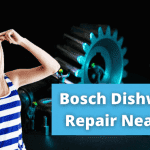Table of Contents
Howdy! So your Frigidaire dishwasher not drying as it should, huh? Feels like you’ve hit a snag, right? You load all your grimy plates and glasses, only to find them soaked as dew on a summer morning. That’s a hot potato of a problem for sure, but don’t worry. We’re going to get your dishwasher cooking with gas again.
| Issue | Fixation Steps |
|---|---|
| Incorrect Drying Cycle | 1. Check your settings panel. 2. Select a cycle with a heated dry phase. 3. Consider opening the dishwasher door slightly post-cycle. |
| Rinse Aid Dispenser Issues | 1. Locate the rinse aid dispenser. 2. Refill if empty. 3. Clean dispenser if clogged. |
| Faulty Heating Element | 1. Unplug dishwasher. 2. Locate the heating element. 3. Check for damage. 4. Replace element if necessary. |
| Defective High-Limit Thermostat | 1. Unplug dishwasher. 2. Locate high-limit thermostat. 3. Check thermostat with multimeter. 4. Replace thermostat if necessary. |
| Stuck Vent Door or Faulty Fan | 1. Locate the dishwasher vent. 2. Check if vent door operates properly. 3. Check if fan spins freely. 4. Repair or replace vent door or fan if necessary. |
Note: These steps should be undertaken by a professional if you’re not comfortable with DIY repairs.
The Nitty-Gritty of Dishwasher Drying
First, let’s get to the nuts and bolts of how dishwashers dry:
- Heated drying: This method cranks up the heat inside the dishwasher to evaporate water while a fan whisks away the moisture.
- Condensation drying: The dishwasher uses a stainless steel tub and hot water. The moist air condenses into droplets on the stainless steel, then drains away. It’s like a well-oiled machine when it works right.
Troubleshooting Your Frigidaire Dishwasher
So, why might your Frigidaire dishwasher act more like a soup kitchen than a drying machine? Let’s dive in:
1. Check your drying cycle:
Are you using a cycle with a heated dry finish? Quick-wash options often skip the heated dry, leaving dishes to air or drip dry.
Step 1: Open your dishwasher and check the settings panel. Make sure you’re selecting a cycle that includes a heated dry phase.
Step 2: If your dishes are still wet after running a heated dry cycle, consider opening the dishwasher door slightly once the cycle finishes. This allows excess steam to escape and can aid the drying process.
2. Examine the rinse aid dispenser:
Rinse aids can help dishes dry faster and prevent water spots. Ensure your dispenser is clear and release the right amount of aid.
Step 1: Locate the rinse aid dispenser. It’s usually on the inside of the dishwasher door.
Step 2: Open the dispenser and check if it’s empty. If it is, refill it according to the manufacturer’s instructions.
Step 3: If the dispenser is full but not releasing rinse aid, it might be clogged. Clean the dispenser with a small brush and warm soapy water, then rinse thoroughly.
3. Assess the heating element:
This is the heart of the heated dry cycle. If it’s broken or not working properly, your dishes will remain wet. You might need a service professional to check this.
Note: Working with electrical elements can be dangerous. If you need clarification, please call a professional.
Step 1: Unplug your dishwasher or turn off the power at the circuit breaker.
Step 2: Locate the heating element. It’s usually at the bottom of the dishwasher.
Step 3: Look for signs of damage or burning. If you spot any, the element will likely need to be replaced. A multimeter can be used to check for continuity in the heating element.
Step 4: If you’re comfortable doing so, you can replace the heating element. Otherwise, call in a professional.
4. Look at the high-limit thermostat:
This nifty part shuts off the heating element if the water gets too hot. If faulty, it might shut off too early, leaving dishes damp.
Note: This also involves working with electrical elements. Proceed with caution and consider hiring a professional.
Step 1: Locate the high-limit thermostat after ensuring your dishwasher is unplugged. It’s usually on the bottom of the dishwasher tub.
Step 2: A multimeter can be used to check if the thermostat has continuity at room temperature.
Step 3: If the thermostat is faulty, it must be replaced. Again, if you need clarification on this, hire a professional.
5. Inspect the vent door:
This releases steamy air during the rinse cycle. If stuck closed, that moisture has nowhere to go, and your dishes stay wet.
Step 1: Find the vent on your dishwasher. It’s typically located on the door or at the top of the dishwasher tub.
Step 2: Check if the vent door is opening and closing properly. It might need to be repaired or replaced if it’s stuck or not opening fully.
Step 3: If your vent has a fan and it’s not spinning freely or making noise, it could also be the culprit. You may need to replace the fan.
So there you have it, my friend. Remember, don’t hesitate to call in a pro when you hit a snag. Now, let’s get your dishwasher smooth as butter again!
FAQs
Q: What else can I do to help my dishes dry?
A: A few things can help. Try unloading the bottom rack first to avoid dripping water from above. Plastic items may need to be hand-dried. Also, ensure your home’s water heater is at least 120 degrees.
Q: How do I check if the fan in my dishwasher is working?
A: You can try spinning the fan blade by hand. If it doesn’t spin freely, you may need a professional to repair or replace it.
Q: Is it worth repairing my dishwasher, or should I replace it?
A: It depends on the issue and the cost. If the repair costs are close to the price of a new dishwasher, you might be better off buying a new one. Remember, a stitch in time saves nine.
You want to avoid returning to the grind of hand-drying dishes. From where I stand, with these tips and some elbow grease, you’ll have your dishwasher cooking with gas and your dishes dry as a bone in no time! Now, let’s get that dishwasher up and running, shall we?




